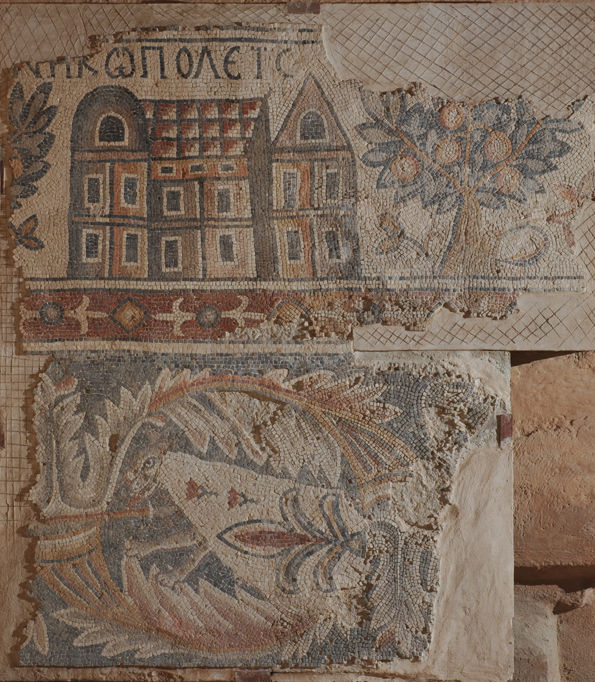The large Jordanian floor mosaics are some of the most provocative objects in the exhibition, a fact made evident in the lively talks at the recent symposium "Floor Mosaics in the Late Antique Mediterranean," which took place at the Met on May 11, 2012. Central to the discussion were two mosaics from Jordan: one from Gerasa, loaned by Yale University, which powerfully dominates the entryway to the galleries; and one from Ma'in, loaned by the Madaba Archeological Park. Although these particular mosaics don't appear in G. W. Bowersock's Mosaics as History: The Near East from Late Antiquity to Islam, the book is fundamental to understanding the major themes and issues relevant to each.
Floor Mosaic Depicting the Cities of Memphis and Alexandria, ca. 540. Made in Jordan, excavated Church of Saints Peter and Paul, Gerasa. Limestone in ivory, dark ocher, beige, light gray, dark gray, and shades of red. Yale University Art Gallery, New Haven, Excavated by the Yale–British School Archaeological Expedition, 1928–29 (1932.1735). Photograph courtesy of Christopher Gardner
Bowersock introduces, in a clear and critical way, the abundant group of Late Antique Near Eastern mosaics. He discusses the practice of representing cities in mosaic, as seen in the piece from Yale, and the reasons for the persistence of pagan stories in the Christian world. He talks about the theater as a source of artistic inspiration. Bowersock also contributes to the ongoing debate about the "scrambled" mosaics in Palestine and Jordan, an example of which is the Ma'in mosaic. Here the body of an animal has been replaced with a white bed of mosaic cubes, which provides the setting for two small flowers and one large foliate design. Who changed these mosaics, when was it done, and why?
Mosaic Depicting Nikopolis Set over an Altered Animal, 719–720 and later. Made in Jordan, excavated Church on the Acropolis, Ma'in. Stone tesserae. Madaba Archeological Park, Jordan
Bowersock argues that when Muslim believers took over Christian churches, they amended the mosaics to conform to injunctions forbidding the depiction of living creatures. He skillfully introduces tricky debates, without a contentious or heavy-handed manner. The book is a wonderful read and provides a sense of this region as one that was unified culturally, despite religious differences:
What secured the relative tranquility of the region was its extraordinarily mixed culture. Many religions and many peoples cohabited together and shared Hellenic traditions they had all inherited. The diversity of the population on the ground is fundamental to understanding the world that the mosaics have exposed.
The book also highlights the paradoxical nature of the art from this period as having been driven simultaneously by tradition and change, continuity and innovation, just as the mosaics from Ma'in show both the original shape of the animal and a completely new image of a white background populated by floating flowers.
About the Book
G. W. Bowersock. Mosaics as History: The Near East from Late Antiquity to Islam. Harvard University Press, Cambridge, MA: 2006.
Further Reading
Flood, Finbarr B. "Christian Mosaics in Early Islamic Jordan and Palestine: A Case of Regional Iconoclasm," in Byzantium and Islam: Age of Transition, 7th–9th Century. Ed. Helen C. Evans. New Haven: Yale University Press, 2012, 117.
Flood, Finbarr B. Islam and Image: Paradoxical Histories. London, forthcoming.
Maguire, Henry. "Moslems, Christians, and Iconoclasm: Erasure from Church Floor Mosaics during the Early Islamic Period," in Byzantine Art: Recent Studies: Essays in Honor of Lois Drewer, ed. Colum Hourihane. Arizona Center for Medieval and Renaissance Studies. Tempe, Arizona: 2009, 111–119.
Schick, Robert. The Christian Communities of Palestine from Byzantine to Islamic Rule: A Historical and Archaeological Study. Darwin Press, 1995.

